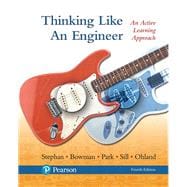For Introduction to engineering courses.
Inspire self-guided inquiry with an active learning model
Thinking Like an Engineer: An Active Learning Approach, 4th Edition is designed to facilitate an active learning environment for first year engineering courses. The authors incorporate a model of learning that encourages self-guided inquiry and advances students beyond “plug-and-chug” and memorization of problem-solving methods. Checkpoints throughout each chapter provide worked out problem sets for students to solve using their own logic, before they are ready to tackle more difficult problems. An emphasis on reading and practice before class prepares students for in-class activities that reinforce the chapter’s material. Students arrive prepared for class, allowing instructors to spend class time focusing on active learning through collaborative problem-solving, computer-based activities, and hands-on experiments that encourage guided inquiry. The 4th Edition provides new material and revisions based on input from instructors and students, as well as current software releases.
Also available with MyLab Engineering.
MyLab™ Engineering is an online homework, tutorial, and assessment program that truly engages students as it offers customized, self-paced learning with instant feedback. MyLab Engineering gives students unlimited opportunity for practice with feedback and help when they need it most. Students will be prepared ahead of class, allowing you to spend class time focusing on active learning.
Note: You are purchasing a standalone product; MyLab™ Engineering does not come packaged with this content. Students, if interested in purchasing this title with MyLab Engineering, ask your instructor for the correct package ISBN and Course ID. Instructors, contact your Pearson representative for more information.
If you would like to purchase both the physical text and MyLab Engineering, search for:
0134642252 / 9780134642253 Thinking Like an Engineer: An Active Learning Approach Plus MyLab Enginerring -- Access Card Package
Package consists of:
- 0134609875 / 9780134609874 MyLab Engineering with Pearson eText -- Access Card -- for Thinking Like an Engineer: An Active Learning Approach
- 0134639677 / 9780134639673 Thinking Like an Engineer: An Active Learning Approach
Students can use the URL and phone number below to help answer their questions:
http://247pearsoned.custhelp.com/app/home
800-677-6337








